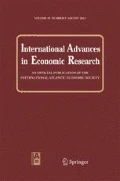Abstract
This paper examines the market response of the reverse stock splits by using the effective date to trace the abnormal returns after reverse splits over the period of 1981 to 2010:3. The findings show that the short-term behavior of the abnormal returns on the effective date is negative and highly significant for all firms. The abnormal returns on the effective month are negative and highly significant. As expected, the cumulative abnormal returns are negative and significant at 10 % level over the period of +1 to +12 months. However, the cumulative abnormal returns from month +13 to month +36 are significantly positive. Our findings also support that institutional investors show confidence by increasing mean holdings of reverse splits of large capital stocks.


Similar content being viewed by others
Notes
The New York Stock Exchange (NYSE) does not require a minimum share price but its listing rules have a provision to consider delisting in the case of an unusually low price. The American Stock Exchange (AMEX) requires a minimum price of $3 per share. The National Association of Securities Dealers (NASDAQ) requires $1 for continued listing. If the share price is less than $1 for ten consecutive days, then NASDAQ enforces this policy for low priced stocks by recommending a reverse splits. The firms will be given 90 days to comply with the exchange requirements.
References
Carhart, M. (1997). On persistence in mutual fund performance. Journal of Finance, 52(1), 57–82.
Desani, H., & Jain, P. (1997). Long-run common stock returns following stock splits and reverse splits. Journal of Business, 70(3), 409–433.
Han, K. C. (1995). The effects of reverse splits on the liquidity of the stock. Journal of Financial and Quantitative Analysis, 30(1), 159–169.
Kim, S., Klein, A., & Rosenfeld, J. (2008). Return performance surrounding reverse stock splits: Can investors profit? Financial Management, 37(2), 173–92.
Koski, J. (2007). Does volatility decrease after reverse stock splits? The Journal of Financial Research, 30(2), 217–235.
Spudeck, R., & Moyer, C. (1985). Reverse splits and shareholder wealth: The impact of commission. Financial Management, 14(4), 52–56.
Woolridge, J., & Chambers, D. R. (1983). Reverse splits and shareholder wealth. Financial Management, 12(3), 5–15.
Author information
Authors and Affiliations
Corresponding author
Rights and permissions
About this article
Cite this article
Hwang, JK., Dimkpah, Y. & Ogwu, A.I. Do Reverse Stock Splits Benefit Long-term Shareholders?. Int Adv Econ Res 18, 439–449 (2012). https://doi.org/10.1007/s11294-012-9370-3
Published:
Issue Date:
DOI: https://doi.org/10.1007/s11294-012-9370-3




